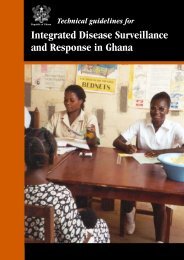Aide Memoire April 2007 - Ministry of Health
Aide Memoire April 2007 - Ministry of Health
Aide Memoire April 2007 - Ministry of Health
Create successful ePaper yourself
Turn your PDF publications into a flip-book with our unique Google optimized e-Paper software.
health infrastructure and services and; iii) fully expanding the health infrastructure and<br />
services. Partners agreed to support the <strong>Ministry</strong> <strong>of</strong> <strong>Health</strong> to complete the plan.<br />
GOVERNANCE<br />
The issues <strong>of</strong> governance centered on the clarification <strong>of</strong> the responsibilities between<br />
MOH and Ghana <strong>Health</strong> Services (GH) and to some extend also NHIS. These, the<br />
meeting was informed, were still being addressed by the government and it was expected<br />
that the issues will be addressed by the revision <strong>of</strong> the laws. Likewise the Act 525 and the<br />
law on decentralization still needs to be fully reconciled, although integrating health<br />
service delivery into the local government system is steadily progressing.<br />
The meeting very much appreciated the increased focus <strong>of</strong> the MOH on performance<br />
management and called for the refining <strong>of</strong> the annual review process in the next Common<br />
Management Arrangement (CMA).<br />
The mechanism for inter sectoral collaboration was highlighted with an agreement that it<br />
should be issues-based. It is expected that the NDPC will provide leadership through<br />
regular meetings on intersectoral issues. Similarly District Administrations are expected<br />
to provide leadership at the district level to promote intersectoral engagement. DPs<br />
working across other sectors should help to promote instersectoral dialogue within their<br />
agencies and programmes.<br />
FINANCING THE HEALTH SECTOR<br />
The presentations and rich discussions on the financing <strong>of</strong> the sector (POW 2006, MBB,<br />
NHA and NHIS, financing scenarios <strong>of</strong> the POW <strong>2007</strong>-2011) demonstrated the<br />
increasingly complex financing architecture <strong>of</strong> the sector. In addition, the amount <strong>of</strong><br />
non-earmarked donor funding available to the <strong>Ministry</strong> <strong>of</strong> <strong>Health</strong> has decreased as donors<br />
contributing to the health fund are either earmarking or moving their support to general<br />
budget support (GBS). This shift to GBS as well as introduction <strong>of</strong> NHIF has led to an<br />
increase in total GOG funding. Earmarked funding has become an increasing part <strong>of</strong><br />
direct donor funding to the sector.<br />
While GOG funding for the sector is increasing, most <strong>of</strong> the increases has gone to item 1<br />
without a concurrent increase to items 2, 3 and 4. The 5YPOW III proposes strategies for<br />
addressing this issue by: i) holding the growth <strong>of</strong> salaries to inflation; ii) limiting growth<br />
in numbers <strong>of</strong> staff; and iii) improving efficiency and labour productivity.<br />
Challenges in planning and budgeting as well as difficulty in accurately predicting the<br />
resource envelope distort the credibility <strong>of</strong> the budget. Lack <strong>of</strong> predictability <strong>of</strong><br />
disbursements contributes to a lack <strong>of</strong> budget discipline and difficulties with<br />
accountability and continues to be a constraint to providing quality health care.<br />
Although predictability <strong>of</strong> disbursements by the MOFEP is improving, more needs to be















